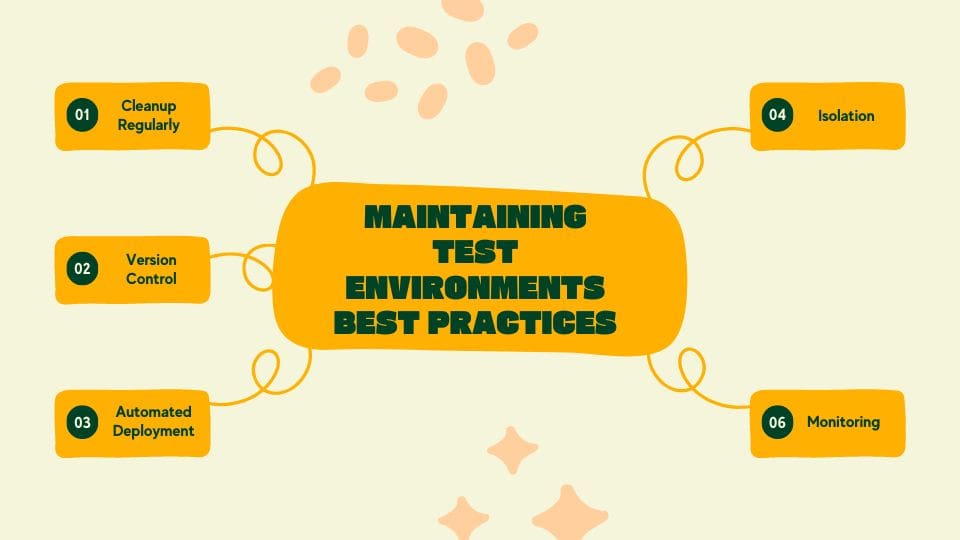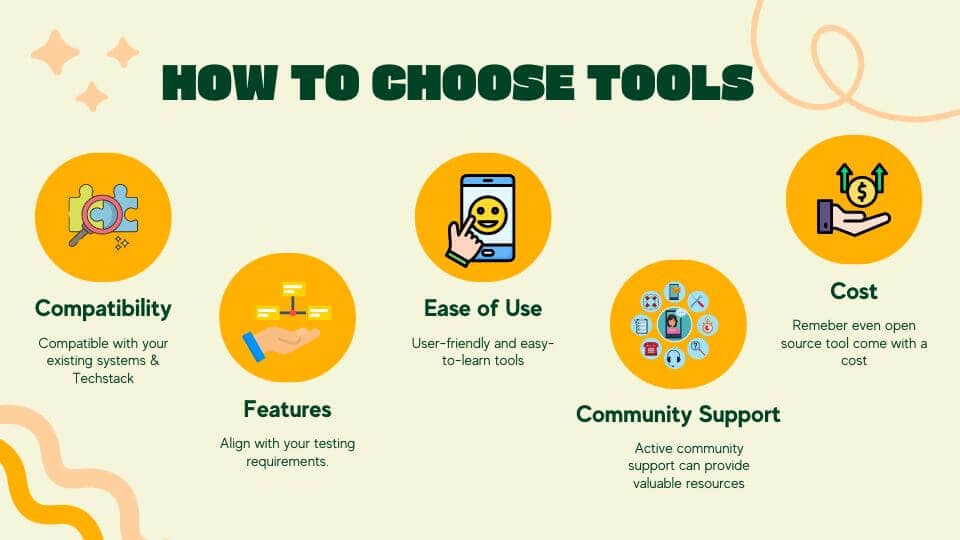Understanding the importance of test environment setup
Test environment setup is crucial for successful test automation. It involves preparing a controlled environment where you can run your tests accurately. A well-structured test environment ensures that your automation tests are reliable and provide meaningful results.
Here are a few reasons why test environment setup is essential:
- Consistency: A consistent test environment helps maintain your tests' stability.
- Isolation: A dedicated test environment prevents interference from other systems or applications, ensuring your testing is not impacted.
- Efficiency: Properly set up environments save time and effort by minimizing setup and configuration errors.
Moreover, having multiple environments can prevent the issues that arise from shared environments, such as tests interfering with each other or with live demos, leading to poor performance and customer dissatisfaction. It's about ensuring consistency and reliability, so your testing doesn't just ‘pass' but accurately reflects what will happen in production.
So, understanding the significance of test environment setup is vital to maximizing the effectiveness of test automation efforts.
I mentioned in my previous post that bad test environments are one of the 4 Destroyers of Any Automation Test Script. But in this article, I want to take a deeper dive on why test environment is critical.
Components of an effective test environment
A practical test environment is crucial for successful test automation. And it's critical in ensuring your software testing is as productive and error-free as possible. Based my extensive expert interviews on my podcast (for example check our Redefining Test Automation A NewPerspective with Dave Piacente) here are the most mentioned components:
- Hardware: The physical components needed for testing.
- Software: The programs and applications required for test execution.
- Network Configuration: Ensuring proper connectivity for test communication.
- Data Management: Handling test data effectively for accurate results.
- Configuration Management: Managing configurations for consistency.
- Tools and Frameworks: Utilizing appropriate tools for automation efficiency.
- Isolation: Your test environment should be isolated from production environments to prevent unintended impacts on live systems. This separation helps maintain the integrity of your production data and operations.
- Replica of Production: It should closely mimic the production environment, including the same hardware, software, and network configurations. This helps in catching bugs that might only appear under specific conditions.
- Data Management: Proper management of test data is vital. It would help if you had mechanisms for managing, maintaining, and resetting data between tests to ensure consistency and reliability.
- Tools and Access: The environment should be equipped with the necessary deployment, monitoring, and debugging tools. Make sure your environments are controlled and limited to just the relevant folks on your team to maintain security and integrity.
- Scalability: It should be scalable to meet the demands of different tests, whether they require more data, higher loads, or additional resources. This flexibility helps in testing under various scenarios and load conditions.
- Monitoring and Logging: It is crucial to implement robust monitoring and logging to track the system's behavior during tests. Good monitoring is an awesome way for you to quickly identify and address issues.
Also in my interviews with Lisa Crispin and Janet Gregory, known for their work on Agile testing, emphasize the importance of continuous feedback loops and environment monitoring to ensure alignment with production conditions.
Check Out all Our Free Testing Courses
How to Choose the Right Tools
The real answer is depends 😊 But seriously selecting the right tools for your teams unique needs is critical to setting yourself up for success.
Before you start take an inventory of your specific needs and the unique challenges of your project. First, assess the technology stack used in your applications. Tools that integrate seamlessly with your stack will reduce setup time and complexity.
Next, consider the skill set of your team.
A tool that requires extensive coding might not be the best choice if your team includes testers with limited programming experience. Sometimes vendor-based tools offer a more user-friendly interface and extensive out-of-the-box features, might be more suitable in such case. Don’t just look at opensource or the most “popular” tools.
Consider the following points when selecting tools for test automation:
- Compatibility: Ensure your chosen tools are compatible with your existing systems and technologies.
- Features: Look for tools with specific features and functionalities that align with your testing requirements.
- Ease of Use: Opt for user-friendly and easy-to-learn tools, as this can save time and effort during the automation process.
- Community Support: Tools with active community support can provide valuable resources, help, and updates for smoother automation.
- Cost: Evaluate the tools' prices and consider whether they fit within your budget while providing the necessary functionalities.
Using the above for helping you decide should give you confidence in your tool selection.
Getting this part right will 100% contribute to the success of your testing initiatives leading to a smooth and efficient testing process.
Establishing a standardized test environment setup process
Establish a consistent process for setting up your automation testing environment.
In this step it’s important that all your team members follow the same process. This will help to reduce errors and save everyone time.
Why?
When everyone uses the same setup process, it becomes easier to troubleshoot issues and collaborate effectively.
That’s why having a standardized test environment setup process is going to help you have a more reliable and successful test automation experience.
Chat with Joe Bot: Your AI Testing Guru
Integrating test environments with continuous integration/continuous deployment (CI/CD) pipelines
Integrating test environments with CI/CD pipelines involves connecting your testing processes with your development and deployment workflows. This integration streamlines your testing efforts, allowing quicker software change feedback. Automating this process ensures that tests run consistently and efficiently at every stage of development.
By incorporating test environments into your CI/CD pipeline, you enhance the reliability and effectiveness of your test automation strategy.
Enhancing collaboration between development and testing teams for better test environment setup
Like everything in your SDLC the environment setup should be a whole team collaborative approach.
Your company needs to enforce the culture of having both developers and testers aligned on team goals. The best way to do this is the most non-technical skill – that is communication.
Communicating will help all team members to be aligned on their goals so everyone can work together efficiently. It also will help foster shared responsibilities making a smooth process for setting up your test environments. Overall collaboration will lead to better coordination, quicker issue resolution, and a more successful test automation strategy.

Implementing best practices for maintaining test environments
Following best practices for maintaining test environments and ensuring smooth testing processes is crucial. Here are some critical tips for implementing these practices:
- Cleanup Regularly: Removing unused or unnecessary files, data etc. This will help keep your test environment clutter-free.
- Version Control: Make sure to track changes and ensure consistency across different environments. Using a version control system, like Git, is the way to go.
- Automated Deployment: Quickly set up or reset test environments by taking advantage of automated deployment processes. This will help your teams saving time and reducing errors.
- Isolation: Keep test environments separate to avoid interference between different tests and ensure accurate results.
- Monitoring: Always monitor the performance of test environments. This is key to finding and fix any issues quickly.
By following these good practices, you can set yourself up to better handle maintain your test environments.
Transform Your Testing in 5 Minutes a Day
Addressing common challenges in test environment setup
Setting up the test environment smoothly is critical to ensuring successful test automation.
Here are a few common challenges during test environment setup:
- Compatibility issues between different software versions
- Limited access to necessary resources, and configuration errors.
By watching out for these common issues it should help you avoid them when setting you your environments.
Monitoring and troubleshooting test environment issues.
Issues in your test environment can disrupt your automation efforts. Monitoring and troubleshooting are essential for maintaining a stable environment. Here are some key points to consider:
- Regularly monitor system performance to catch any issues early.
- Utilize logging and alerting systems to identify and address problems promptly.
- Conduct regular health checks to ensure all components are functioning correctly.
- Collaborate closely with your team to swiftly troubleshoot any issues that arise.
Measuring and optimizing test automation success through strategic test environment setup
Ok as you have seen measuring and optimizing test automation success starts with a strategic test environment setup that aligns with your testing goals. Here are a few more ideas to help:
1.Leverage Real-Time Monitoring: Implement robust monitoring tools to track the performance and stability of your test environments. This can help you quickly identify and address issues that could impact test accuracy or execution times.
2.Automate Environment Provisioning: Use infrastructure as code (IaC) tools to automate the setup and teardown of your test environments. This ensures consistency and speeds up the process, allowing more time for actual testing and less for configuration.
3.Integrate with CI/CD Pipelines: Ensure your test environments are integrated into your CI/CD pipelines. This facilitates continuous testing and helps in identifying integration issues early in the development cycle.
4. Use Service Virtualization: To avoid delays caused by unavailable or unstable dependencies, use service virtualization. This allows you to simulate dependent systems and APIs, ensuring your testing is not blocked and remains thorough.
5. Optimize Test Data Management: Implement tools and processes for effective test data management. This includes creating realistic and up-to-date datasets that mimic production data, which is crucial for accurate test results.
6. Regularly Review and Adapt your strategy based on feedback and performance metrics. Regular assessments can help you fine-tune both the environment and the tests themselves to maximize efficiency and effectiveness.
By focusing on these strategies, you can ensure that your test automation efforts are not only successful but also aligned with the broader goals of your company.







